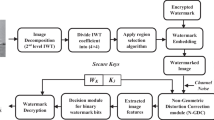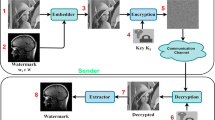Abstract
In this paper, two logistic-map based fragile image watermarking schemes are proposed. The first scheme is a conventional irreversible, whereas the second scheme is a reversible one. The proposed first scheme considers a pair of two consecutive host image (HI) pixels for embedding the watermark bits. At the embedding end, each HI pixel observes a maximum of ±1 modifications to produce the watermarked pixels. At the same time, the second scheme utilizes the concept of mirrored images of the HI to reproduce the image as well as the watermark bits, with minimal distortion. The experimental results show that the quality of the watermarked image is superior with an average peak signal-to-noise ratio (PSNR) of more than 51 dB for both schemes. Also, the first scheme offers excellent tamper detection and localization ability as compared to the existing state-of-art schemes. Besides, promising results are obtained in favor of the proposed scheme for measures like accuracy, true positive (TP), true negative (TN), false positive (FP), false negative (FN), and precision.

















Similar content being viewed by others
References
Abdelhakim A, Saleh HI, Abdelhakim M (2019) Fragile watermarking for image tamper detection and localization with effective recovery capability using K-means clustering. Multimed Tools Appl 78(22):32523–32563
Agarwal N, Singh AK, Singh PK (2019) Survey of robust and imperceptible watermarking. Multimed Tools Appl 78(7):8603–8633
Bal SN, Nayak MR, Sarkar SK (2018) On the implementation of a secured watermarking mechanism based on cryptography and bit pairs matching. J King Saud Univ Comput Inform Sci. https://doi.org/10.1016/j.jksuci.2018.04.006
Bhalerao S, Ansari IA, Kumar A (2021) A secure image watermarking for tamper detection and localization. J Ambient Intell Humaniz Comput 12:1057–1068
Bolourian Haghighi B, Taherinia AH, Monsefi R (2020) An effective semi-fragile watermarking method for image authentication based on lifting wavelet transform and feed-forward neural network. Cogn Comput 12:863–890
Chang CC, Hu YS, Lu TC (2006) A watermarking-based image ownership and tampering authentication scheme. Pattern Recogn Lett 27(5):439–446
Chang CC, Chen KN, Lee CF, Liu LJ (2011) A secure fragile watermarking scheme based on chaos-and-hamming code. J Syst Softw 84(9):1462–1470
Gong LH, Tian C, Zou WP, Zhou NR (2021) Robust and imperceptible watermarking scheme based on canny edge detection and SVD in the contourlet domain. Multimed Tools Appl 80(1):439–461
Gull S, Loan NA, Parah SA, Sheikh JA, Bhat GM (2018) An efficient watermarking technique for tamper detection and localization of medical images. J Ambient Intell Humaniz Comput 11:1799–1808
Hemida O, He H (2020) A self-recovery watermarking scheme based on block truncation coding and quantum chaos map. Multimed Tools Appl 79:18695–18725. https://doi.org/10.1007/s11042-020-08727-7
Hemida O, Huo Y, He H, Chen F (2019) A restorable fragile watermarking scheme with superior localization for both natural and text images. Multimed Tools Appl 78(9):12373–12403
Korus P (2017) Digital image integrity–a survey of protection and verification techniques. Digit Signal Process 71:1–26
Kumar C, Singh AK, Kumar P (2018) A recent survey on image watermarking techniques and its application in e-governance. Multimed Tools Appl 77(3):3597–3622
Laouamer L, AlShaikh M, Nana L, Pascu AC (2015) Robust watermarking scheme and tamper detection based on threshold versus intensity. J Innov Digit Ecosyst 2(1–2):1–12
Li CT, Yuan Y (2006) Digital watermarking scheme exploiting nondeterministic dependence for image authentication. Opt Eng 45(12):127001
Luo Y, Li L, Liu J, Tang S, Cao L, Zhang S, Cao Y (2021) A multi-scale image watermarking based on integer wavelet transform and singular value decomposition. Expert Syst Appl 168:114272
Molina-Garcia J, Garcia-Salgado BP, Ponomaryov V, Reyes-Reyes R, Sadovnychiy S, Cruz-Ramos C (2020) An effective fragile watermarking scheme for color image tampering detection and self-recovery. Signal Process Image Commun 81:115725
Nazari M, Mehrabian M (2021) A novel chaotic IWT-LSB blind watermarking approach with flexible capacity for secure transmission of authenticated medical images. Multimed Tools Appl 80(7):10615–10655
Nazari M, Sharif A, Mollaeefar M (2017) An improved method for digital image fragile watermarking based on chaotic maps. Multimed Tools Appl 76(15):16107–16123
Phan RCW (2008) Tampering with a watermarking-based image authentication scheme. Pattern Recogn 41(11):3493–3496
Prasad S, Pal AK (2020) A tamper detection suitable fragile watermarking scheme based on novel payload embedding strategy. Multimed Tools Appl 79(3):1673–1705
Prasad S, Pal AK (2020) A secure fragile watermarking scheme for protecting integrity of digital images. Iran J Sci Technol Trans Electri Eng 44:703–727
Qiu Y, Duan H (2021) A novel multi-stage watermarking scheme of vector maps. Multimed Tools Appl 80(1):877–897
Rahman AU, Sultan K, Musleh D, Aldhafferi N, Alqahtani A, Mahmud M (2018) Robust and fragile medical image watermarking: a joint venture of coding and chaos theories. J Healthcare Eng 2018:1–11. https://doi.org/10.1155/2018/8137436
Rajesh S, Paul V, Menon VG, Khosravi MR (2019) A secure and efficient lightweight symmetric encryption scheme for transfer of text files between embedded IoT devices. Symmetry 11(2):293
Salemi, H., Rostami, H., Talatian-Azad, S., & Khosravi, M. R. (2021). LEAESN: predicting DDoS attack in healthcare systems based on Lyapunov exponent analysis and Echo state neural networks. Multimedia Tools Appl, 1-22. https://doi.org/10.1007/s11042-020-10179-y
Shynu PG, Nadesh RK, Menon VG, Venu P, Abbasi M, Khosravi MR (2020) A secure data deduplication system for integrated cloud-edge networks. J Cloud Comput 9(1):1–12
Sreenivas K, Prasad VK (2018) Fragile watermarking schemes for image authentication: a survey. Int J Mach Learn Cybern 9(7):1193–1218
Sultan K, Aldhafferi N, Alqahtani A, Mahmud M (2018) Reversible and fragile watermarking for medical images. Comput Math Methods Med 2018. https://doi.org/10.1155/2018/3461382
Tavallali P, Yazdi M, Khosravi MR (2019) Robust cascaded skin detector based on AdaBoost. Multimed Tools Appl 78(2):2599–2620
Trivedy S, Pal AK (2017) A logistic map-based fragile watermarking scheme of digital images with tamper detection. Iran J Sci Technol Trans Electri Eng 41(2):103–113
Walton S (1995) Information authentication for a slippery new age. Dr Dobb’s J 20(4):18–26
Yu M, Wang J, Jiang G, Peng Z, Shao F, Luo T (2015) New fragile watermarking method for stereo image authentication with localization and recovery. AEU-Int J Electron Commun 69(1):361–370
Funding
This is an independent work. No funding has been received to conduct this research.
Author information
Authors and Affiliations
Corresponding author
Ethics declarations
Conflict of interest
The authors declare that they have no conflict of interest.
Additional information
Publisher’s note
Springer Nature remains neutral with regard to jurisdictional claims in published maps and institutional affiliations.
Rights and permissions
Springer Nature or its licensor holds exclusive rights to this article under a publishing agreement with the author(s) or other rightsholder(s); author self-archiving of the accepted manuscript version of this article is solely governed by the terms of such publishing agreement and applicable law.
About this article
Cite this article
Sahu, A.K., Hassaballah, M., Rao, R.S. et al. Logistic-map based fragile image watermarking scheme for tamper detection and localization. Multimed Tools Appl 82, 24069–24100 (2023). https://doi.org/10.1007/s11042-022-13630-4
Received:
Revised:
Accepted:
Published:
Issue Date:
DOI: https://doi.org/10.1007/s11042-022-13630-4




